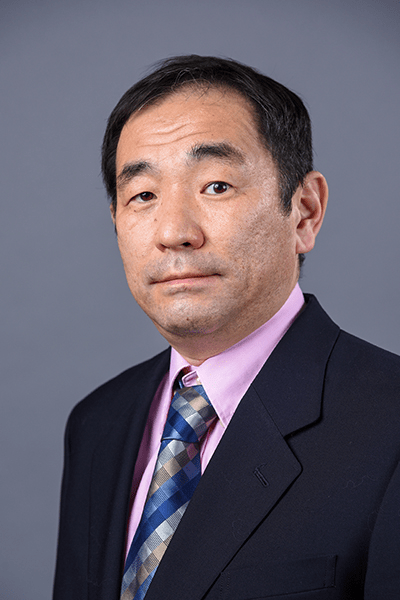
Yuichiro Takagi, PhD
Associate Professor of Biochemistry, Molecular Biology & Pharmacology
- Phone
- (317) 274-2719
- Address
-
635 Barnhill Drive
Medical Science, Room MS4003
Indianapolis, IN 46202 - PubMed:
-

Bio
Dr. Takagi received a BS degree in Chemistry from Ibaraki University, and a MS degree in Chemistry from The University of Tokyo in Japan. After obtaining a MS, he moved to the US, and completed with his PhD work with his thesis advisors, Drs. Joan and Ron Conaway at Oklahoma Medical Research Foundation (OMRF), Department of Biochemistry and Molecular Biology at University of Oklahoma Health Sciences Center. After receiving his PhD, Dr. Takagi became a postdoctoral fellow at the laboratory of Dr. Roger Kornberg (Nobel Laureate 2006) in the Department of Structural Biology at Stanford University. In Kornberg laboratory, Dr. Takagi began to investigate the structure and function of the large multi-protein complex, Mediator, aiming to understand the mechanisms of RNA polymerase II transcription regulation by Mediator in eukaryotes. After completion of his postdoctoral fellowship (1998-2003) followed by working as a research associate (2003-2006), he became an Assistant Professor in Indiana University School of Medicine in the fall of 2006. He was promoted to an Associate Professor with tenure in 2011-2012.
Takagi laboratory is interested in understanding the mechanisms of assembly, structure and function of large multi-protein complexes -“molecular machines” - involved in eukaryotic gene regulation. His lab is particularly interested in the Mediator complex in both yeast and humans. Dr. Takagi believes that development and implementation of novel technologies is the key to unlocking the mysteries of how highly complex molecular machines (e.g. Mediator) function. Therefore, the overall research goal is two-fold: (i) development of novel technologies for studying multi-protein complexes, and (ii) application of these technologies to elucidate the structure and function of the Mediator complex. In addition, Takagi lab has developed a novel technology for producing pure preparations of difficult-to-express proteins and protein complexes, which has enabled several exciting ongoing projects with outstanding collaborators working on: plant RNA polymerases, DNA helicases, DNA repair complexes, RNA editing complex, and insulator complex.
A postdoctoral position, and a research associate (staff scientist) position, are currently available
Key Publications
For a complete list of publications, visit PubMed| Year | Degree | Institution |
|---|---|---|
| 1997 | PhD | University of Oklahoma |
| 1989 | MS | University of Tokyo |
| 1987 | BS | Ibaraki University |
The concept of the cell as a collection of multi-subunit protein complexes, molecular machines, is emerging as a cornerstone of modern biology. Class II gene transcription is a prime example for this concept. Eukaryotic transcription by RNA polymerase II is driven by series of molecular machines. Representative steps include modification of chromatin templates, gene-specific initiation, transcription elongation and termination. Deciphering structures of these molecular machines and their interactions at high resolution is vital to understand biology. Moreover, since mutations in various subunits of these complexes are associated with diseases such as cancer, studies of these complexes are of clinical importance as they might serve as the next generation of drug targets for treatments of many human diseases.
The focus of my laboratory is to investigate the structure and function of large multi-protein complexes in gene expression in eukaryotes. The preparations of many essential molecular machines can be a considerable challenge due to the low abundance and heterogeneity often associated with their extraction from native sources. Therefore, our approach takes advantage of our expertise to generate multi-protein complexes in recombinant forms for structural and functional studies by utilizing the advanced protein complex expression technologies (see refs 1-3). We have successfully applied our expertise to generate the recombinant Mediator Head module (7 subunits, 223 kDa), an essential sub-complex of Mediator of transcription regulation, in a large quantity, which led us to solve the Head structure first by cryo-EM (ref. 7) and eventually by X-ray crystallography (ref. 5) (see Figure 1) - Our crystal structure has revealed how this essential complex is built from its components combining stability as well as flexibility for transcription regulation, providing a platform for other transcription factors (ref. 5) (see Figure 1).
The current projects include (i) reconstitution and structure determination of the entire Mediator complex, which is composed of 21 subunits (see Figure 1), (ii) structure-guided functional studies of the mechanisms of Mediator, (iii) reconstitution of multi-protein complexes involved in gene expressions, and (iv) engineering of protein complex expression and purification technologies.
My laboratory has established expertise uniquely positions us to undertake structural and functional studies of molecular machines, aiming toward elucidation of mechanisms of regulation in eukaryotic gene expressions.
Desc: Bert Elwert Award in Medicine
Scope: School
Date: 1905-07-15